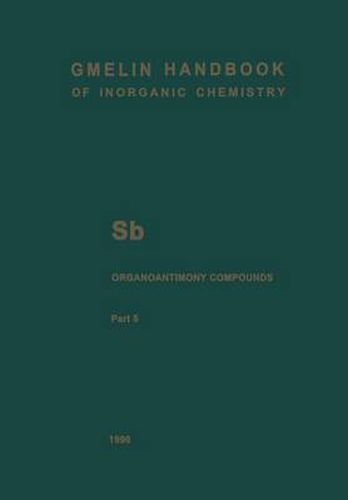Readings Newsletter
Become a Readings Member to make your shopping experience even easier.
Sign in or sign up for free!
You’re not far away from qualifying for FREE standard shipping within Australia
You’ve qualified for FREE standard shipping within Australia
The cart is loading…






This title is printed to order. This book may have been self-published. If so, we cannot guarantee the quality of the content. In the main most books will have gone through the editing process however some may not. We therefore suggest that you be aware of this before ordering this book. If in doubt check either the author or publisher’s details as we are unable to accept any returns unless they are faulty. Please contact us if you have any questions.
This fifth volume on organoantimony compounds continues the description of pentavalent antimony compounds and concludes the entire series. The treatment of pentavalent compounds with three Sb-C bonds began in Part 4 with the RSbX type and is now completed with types RSb(X)Y, RR'SbX , RR'Sb(X)Y, 3 2 3 2 2 2 RR'R SbX (Section 2.5.1) and the corresponding bi- and trinuclear compounds (Sec- 2 tions 2.5.2, p.87, and 2.5.3, p. 132). R, R’, and R denote different organic groups bonded through carbon to the antimony atom. X and Y represent inorganic or organic groups that are bonded to antimony by an atom other than carbon. R, X, and/or Y can also be chelating ligands. The remaining part of the volume completeLy covers all pentavalent antimony compounds containing two Sb-C bonds (RSbX , RSb(X )Y, RR'SbX , RR'Sb(X )Y, bi- and tetranucLear 2 3 2 2 3 2 compounds, Chapter 2.6, p. 134) and those containing one Sb-C bond (RSbX , RSb(X )Y, 4 3 RSb(X)Y , bi- and trinucLear compounds, Chapter 2.7, p. 237). These compounds form ad- 2 2 ducts with Lewis bases (symbol D) and form many ionic compLexes by the addition of saLts such as amine hydrochLorides (symbol MZ). The adducts and ionic compLexes are described immediately after the parent substances. The volume concludes with an Empirical Formula Index (p. 318) and a Ligand Formula Index (p. 357).
$9.00 standard shipping within Australia
FREE standard shipping within Australia for orders over $100.00
Express & International shipping calculated at checkout
This title is printed to order. This book may have been self-published. If so, we cannot guarantee the quality of the content. In the main most books will have gone through the editing process however some may not. We therefore suggest that you be aware of this before ordering this book. If in doubt check either the author or publisher’s details as we are unable to accept any returns unless they are faulty. Please contact us if you have any questions.
This fifth volume on organoantimony compounds continues the description of pentavalent antimony compounds and concludes the entire series. The treatment of pentavalent compounds with three Sb-C bonds began in Part 4 with the RSbX type and is now completed with types RSb(X)Y, RR'SbX , RR'Sb(X)Y, 3 2 3 2 2 2 RR'R SbX (Section 2.5.1) and the corresponding bi- and trinuclear compounds (Sec- 2 tions 2.5.2, p.87, and 2.5.3, p. 132). R, R’, and R denote different organic groups bonded through carbon to the antimony atom. X and Y represent inorganic or organic groups that are bonded to antimony by an atom other than carbon. R, X, and/or Y can also be chelating ligands. The remaining part of the volume completeLy covers all pentavalent antimony compounds containing two Sb-C bonds (RSbX , RSb(X )Y, RR'SbX , RR'Sb(X )Y, bi- and tetranucLear 2 3 2 2 3 2 compounds, Chapter 2.6, p. 134) and those containing one Sb-C bond (RSbX , RSb(X )Y, 4 3 RSb(X)Y , bi- and trinucLear compounds, Chapter 2.7, p. 237). These compounds form ad- 2 2 ducts with Lewis bases (symbol D) and form many ionic compLexes by the addition of saLts such as amine hydrochLorides (symbol MZ). The adducts and ionic compLexes are described immediately after the parent substances. The volume concludes with an Empirical Formula Index (p. 318) and a Ligand Formula Index (p. 357).